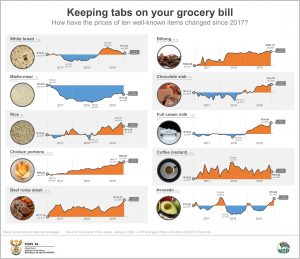Making rands and sense of price data
How much do South Africans pay for groceries? Stats SA has released a list with prices of 191 popular retail items with data going back to 2017. The list holds some surprises.
Pulled from that list, each item in the graphic below has its own unique story. The national average price of a loaf of white bread has wandered up and down since January 2017, dropping to a low in December of that year and peaking in May 2019. The average price of R13,51 for a loaf in January 2020 was only 10c higher than three years earlier. The price of mielie-meal (1 kg super maize) was 12,0% cheaper in January 2020 than it was at the beginning of 2017 (click on the graphic to enlarge).
Meat prices have increased notably. A kilogram of juicy rump steak is 15% more expensive than it was in January 2017.
If you are not a big meat eater but enjoy salads, you are probably joining the ranks of South Africans distressed at the current avocado shortage.1 As a seasonal fruit, avocado prices fluctuate markedly over the course of the year. The average price of a single avocado pear in June 2018 was R6,78. In January 2020, the price was R18,04 (ouch!). That’s one good thing about winter – avos are affordable.
Think of your own grocery bill. What items do you frequently buy? There is a chance that these might be included in this newly published price list that covers a range of food, drink, medical, and toiletry products.
Previously available to researchers on request, Stats SA decided – from February 2020 onwards – to release the list to a wider audience on our website. To explore the data for yourself, download the CPI_Average Prices_All urban and CPI_Average prices_Provinces Excel files from the Consumer Price Index (CPI) release download page, under the Time series data section. One file covers national data while the other offers a provincial breakdown.
Want to impress your friends around the braai? Turn to the provincial data. Did you know that a bottle of whiskey is most expensive in Northern Cape and cheapest in Eastern Cape? Gauteng is the most expensive province for cigarettes, bug spray, toothpaste and laundry soap, while instant noodles, potato crisps and custard are most expensive in Western Cape. Free State has the highest prices for eye drops and bubble bath. If you happen to live in KwaZulu-Natal, you are paying the highest prices for deodorant.
What makes the average price list unique is that it provides the rand value of prices. Up until now, Stats SA has only published price data in the form of indices in the CPI release. Price indices might seem a little unsettling to those unfamiliar with statistics. Average price data provide an everyday, familiar sense of how much things actually cost.
Average prices are useful for poverty research too. A number of organisations use the list to compile national grocery baskets. Examples include baskets developed by the National Agriculture Marketing Council and Studies in Poverty and Inequality Institute.
If you are a data nerd, you can build your own basket from the data if you like, choosing the items that you usually buy and seeing how the total price compares with what you actually pay.
One important point though. The key word to keep in mind here is average. The figures are derived from price data used to compile the CPI release. Price collectors visit retail outlets every month to record thousands of prices for a wide range of consumer items. The price listed for an avocado pear is the national average of prices collected for a large number of avocados.
Go ahead, download the Excel files for January 2020 here and take a look!
1 Business Insider, There’s a shortage of avocados in South Africa – and you can expect to pay R25 for one, if you can find it, 6 February 2020 (read here).
Similar articles are available on the Stats SA website and can be accessed here.
For a monthly overview of economic indicators and infographics, catch the latest edition of the Stats Biz newsletter here.


